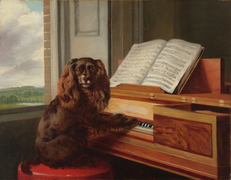An Extraordinary Musical Prodigy
Thursday, July 5, 2018

This spaniel hasn’t just hopped on the piano stool to howl at whatever noise comes out of that wooden box. If the title of the painting is any indication, Portrait of an Extraordinary Musical Dog, this pooch has some real talent. The artist Philip Reinagle (1749-1833) depicts a dog whose paws are poised to play from the music manuscript that is opened up in front of him. He looks like he has been caught in the act of performing—or maybe he just needs some help turning the page.
Though the square piano is likely an English Broadwood piano from ca. 1795 and the music is recognizable as “God Save the King” (fitting for the King Charles Spaniel depicted), the piano omits details such as strings and a name on the nameplate. Given this discrepancy between the real and imagined—and given the fact that we’re talking about a piano-playing dog, after all—how seriously is one to take the subject of this artwork? Laurence Libin, who identifies the above details about the piano and the music in a 1998 article, sees a possible connection between the trained pup in the painting and the English pianist and composer William Crotch (1775-1847), who was born 243 years ago today.
Crotch was a musical wonder who could dabble convincingly on the piano by the age of 1-1/2, and when he was two “God Save the King” is known to have been part of his repertoire. Before the decade was out, he played in Buckingham Palace for the royal couple and even got a mention from Charles Burney. He was famous throughout Great Britain for being a child prodigy.
When this painting was completed, by 1805 at the latest, Crotch was an adult but had continued to impress, having been appointed organist at Christ Church in Oxford at the age of 15, completing a doctorate in music and continuing as a professor.
Libin proposes that Reinagle could have had this human prodigy in mind, though he admits freely that there is no concrete evidence for this. The link between the music readable on the manuscript and the infant Crotch’s parlor trick is…fetching.
Crotch began composing at a young age. The oratorio The Captivity of Judah (ca. 1786) is among his earliest, and an autograph manuscript of it is at the British Library (GB-Lbl Add. 30388; RISM ID no. 806040275). As a composer, Crotch is in the RISM database just over 40 times, in which the majority of his sources are sacred songs and anthems. Crotch is also named on over 100 additional sources (search for Crotch in the Advanced search in the field Other names), where he is a copyist, arranger, and former owner. His arrangements of keyboard pieces in the second part of a manuscript held by the Conservatoire royal de Bruxelles - Koninklijk Conservatorium Brussel (B-Bc) might provide a taste of his piano style (RISM ID no. 703002174).
While RISM does not have any arrangements of “God save the King” in the key of F as depicted in the painting, arrangements can be found in a handful of British sources (including 4 for keyboard) that give an idea of the context that the tune appeared in prior to 1800.
Is Reinagle’s painting really a “veiled satire” on Crotch, as Libin suggests? Even if it is not, Libin continues, the painting can be seen as a comment on any well-trained child prodigy from the time.
Sources:
Laurence Libin, “Philip Reinagle’s ‘Extraordinary Musical Dog’,” Music in Art 23, no. 1/2 (Spring-Fall 1998): 97-100. Available online.
Nicholas Temperley and Simon Heighes, “Crotch, William,” Grove Music Online, retrieved 12 June 2018.
Image: Philip Reinagle, Portrait of an Extraordinary Musical Dog, 1805. Virginia Museum of Fine Arts, Richmond. CC BY-NC. RIdIM record ID: 5041
Share Tweet EmailCategory: Musical anniversaries

